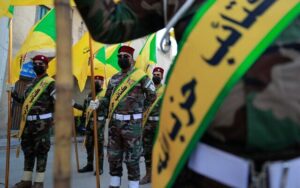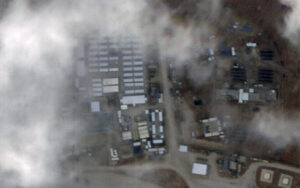Strikes hit over 85 targets including command HQs, intelligence centers, weapons facilities connected to Iran and regional proxies, in response to assault that killed 3 US soldiers
By TARA COPP, Lolita C. Baldor and ABDULRAHMAN ZEYA
WASHINGTON (AP) — The US military launched an air assault on dozens of sites in Iraq and Syria used by Iranian-backed militias and the Islamic Revolutionary Guard Corps (IRGC) Friday, in the opening salvo of retaliation for the drone strike that killed three US troops in Jordan last weekend.
President Joe Biden said in a statement: “The United States does not seek conflict in the Middle East or anywhere else in the world. But let all those who might seek to do us harm know this: If you harm an American, we will respond.”
Biden and other top US leaders had been warning for days that America would strike back at the militias, and they made it clear it wouldn’t be just one hit but a “tiered response” over time. Biden made that point again in his statement, saying: “Our response began today. It will continue at times and places of our choosing.”
The massive barrage of strikes hit more than 85 targets at seven locations, including command and control headquarters, intelligence centers, rockets and missiles, drone and ammunition storage sites and other facilities that were connected to the militias or the IRGC’s Quds Force, the Guard’s expeditionary unit that handles Tehran’s relationship with and arming of regional militias.
The US strikes appeared to stop short of directly targeting Iran or senior leaders of the IRGC’s Quds Force within its borders, as the US tries to prevent the conflict from escalating even further. Iran has denied it was behind the Jordan attack.
National Security Council spokesman John Kirby said the targets “were carefully selected to avoid civilian casualties and based on clear, irrefutable evidence that they were connected to attacks on US personnel in the region.” He declined to detail what that evidence was.

The strikes took place over about 30 minutes, and three of the sites struck were in Iraq and four were in Syria, said Lt. Gen. Douglas Sims, director of the Joint Staff.
US Central Command said the strikes used more than 125 precision munitions, and they were delivered by numerous aircraft, including long-range B-1 bombers flown from the United States. Sims said weather was a factor as the US planned the strikes in order to allow the US to confirm it was hitting the right targets and avoiding civilian casualties.
It’s not clear, however, whether militia members were killed.
“We know that there are militants that use these locations, IRGC as well as Iranian-aligned militia group personnel,” Sims said. “We made these strikes tonight with an idea that there there would likely be casualties associated with people inside those facilities.”
Two Iraqi militia officials who spoke on condition of anonymity because they were not authorized to speak to journalists said that three houses used as headquarters were targeted in al-Qaim, Iraq, including a weapons storage area. An operations headquarters of the Popular Mobilization Forces, a coalition of Iranian-backed militias, in Akashat, Iraq, and weapons stores were targeted.
The assault came just hours after Biden and top defense leaders joined grieving families to watch as the remains of the three Army Reserve soldiers were returned to the US at Dover Air Force Base in Delaware.

It was unclear what the next steps will be, or whether the days of US warnings have sent militia members scattering into hiding, making it more difficult to detect and strike them. But it was evident that the recent statement released by Kataeb Hezbollah, one of the main Iran-backed militias, saying it was suspending attacks on American troops had no impact on the administration’s plans.
Just Friday morning, Iran’s hardline President Ebrahim Raisi reiterated earlier promises by Tehran to potentially retaliate for any US strikes targeting its interests. We “will not start a war, but if a country, if a cruel force wants to bully us, the Islamic Republic of Iran will give a strong response,” Raisi said.
In a statement this week, Kataeb Hezbollah announced “the suspension of military and security operations against the occupation forces in order to prevent embarrassment to the Iraqi government.” But Harakat al-Nujaba, one of the other major Iran-backed groups, vowed Friday to continue military operations against US troops.
The US has blamed the Islamic Resistance in Iraq, a broad coalition of Iran-backed militias, for the deadly attack in Jordan, but has not yet narrowed it down to a specific group. Kataeb Hezbollah is, however, a top suspect.

Some of the militias have been a threat to US bases for years, but the groups intensified their assaults in the wake of Israel’s war against Hamas following the October 7 attack on Israel that killed 1,200 people and saw 250 others taken hostage.
The war has led to the deaths of more than 27,000 Palestinians in the Gaza Strip since October 7, according to the Hamas-run Gaza health ministry. The terror group’s figures are unverified, don’t differentiate between civilians and combatants, and list all the fatalities as caused by Israel — even those believed to have been caused by hundreds of misfired rockets or otherwise by Palestinian fire.
Israel has previously said it has killed some 10,000 Hamas members, in addition to some 1,000 killed in Israel in the aftermath of the terror group’s October 7 invasion and onslaught.
Iran-backed militia groups throughout the region have used the conflict to justify striking Israeli or US interests, including threatening civilian commercial ships and US warships in the Red Sea region with drones or missiles in almost daily exchanges.
Speaking to reporters on Thursday, Defense Secretary Lloyd Austin said that “this is a dangerous moment in the Middle East.” He added, “We will take all necessary actions to defend the United States, our interests and our people. And we will respond when we choose, where we choose and how we choose.”
“At this point, it’s time to take away even more capability than we’ve taken in the past,” Austin said.
As of Tuesday, Iran-backed militia groups had launched 166 attacks on US military installations since Oct. 18, including 67 in Iraq, 98 in Syria and now one in Jordan, according to a US military official. The last attack was Jan. 29 at at al-Asad airbase in Iraq, and there were no injuries or damage.
The US, meanwhile, has bolstered defenses at the base in Jordan that was attacked by the ran-backed militants on Sunday, according to a US official.
And the Israeli military said its Arrow defense system intercepted a missile that approached the country from the Red Sea, raising suspicion it was launched by Yemen’s Houthi rebels. The rebels did not immediately claim responsibility.
A US official also said the military had taken additional self-defense strikes inside Yemen Friday against Houthi military targets deemed an imminent threat. Al-Masirah, a Houthi-run satellite news channel, said that British and American forces conducted three strikes in the northern Yemeni province of Hajjah, a Houthi stronghold.
While previous US responses in Iraq and Syria have been more limited, the attack on Tower 22, as the Jordan outpost is known, and the deaths of the three service members crossed a line, the official said.

That drone attack, which also injured more than 40 service members — largely Army National Guard — was the first to result in US combat deaths from the Iran-backed militias since the war between Israel and Hamas broke out. Tower 22 houses about 350 US troops and sits near the demilitarized zone on the border between Jordan and Syria. The Iraqi border is only 6 miles (10 kilometers) away.
Also on Friday, the US Treasury imposed new sanctions on a network of firms in Iran and Hong Kong that are accused of helping Iran procure technology to make ballistic weapons and drones. And the US hit six Iranian officials with sanctions for allegedly committing a series of malicious cyber activities against critical infrastructure in the US and other nations.



Leave a Reply
You must be logged in to post a comment.